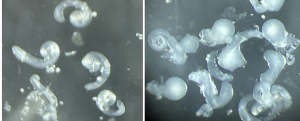Our Research Overview
Our lab investigates the mechanisms of stem cell regulation and how dysregulation may lead to disease states. Specifically, we utilize the powerful Drosophila Melanogaster as our model system, due to its simple anatomy. This in conjunction with abundant genetic and genomic tools has proven to be well suited to study unrecognized regulatory mechanisms. We combine advanced imaging techniques, genetics, and multi-omics approaches to study germline stem cells (GSCs), factors that may play a role in cell fates, and chromatin architecture within the cells of normal tissues and diseased tissues. Our research is focused on a few areas, such as chromatin state dynamics, the roles of nuclear non-coding RNAs in stem cell function and changes in extracellular matrix during tissue regeneration. Ultimately, we aim to deepen our knowledge of disease progression and contribute to developing new approaches to disease therapies and prevention.
Why is it important to understand how stem cells are regulated?

Understand how diseases occur.
As stem cells have the capacity to divide long-term and keep producing tissue cells, their dysregulation results in many disease conditions, including cancers, tissue degeneration, and aging. A better understanding of these conditions helps us to develop new therapeutic strategies for incurable diseases.

Projects:
Roles of Transposable Elements in Drosophila Spermatocytes
In Drosophila spermatocytes, RNAs and RNPs associate with loop-like structures on the Y chromosome, known as Y-loops, which are hypothesized to regulate the expression of Y-linked fertility genes. We aim to investigate the functions of these RNA-based nuclear domains and their influence on transcription and other nuclear processes. We recently discovered that transcripts from numerous transposons serve as central structural components of chromosome-associated RNPs. Notably, different transposons exhibit distinct localization patterns within spermatocyte nuclei. We are investigating the mechanisms governing this localization pattern and their roles in spermatogenesis.


Chromatin Regulation on the Oncogenic gene loci in Drosophila Tumor Model
Our genome is not linear. Rather, our DNA is intricately organized and wrapped in the nucleus. Understanding the relation between genome structure and genome function (gene expression) may be crucial to further elucidating disease formation and development. Specifically, in our previous studies, we looked at the Stat92E gene locus, that encodes for a highly conserved protein involved in a gene expression signaling cascade necessary for maintaining germline stem cell identity. Interestingly, we found a relationship between homolog pairing (maternal and paternal homologs physically interacting) at this locus and stem-cell differentiation and gene expression. A Stat92E dependent tumor can be experimentally induced, where we can investigate how the Stat92E oncogenic locus may behave in tumor progression. Now, we want to further understand these relationships and understand chromatin architecture in tumorigenic cells, where we utilize stem-cell like tumor tissues and study the Stat92E locus and its surrounding regions.
Exploring the Mechanisms of Dedifferentiation in the Drosophila Testis Stem Cell System
The Drosophila testis stem cell niche is a robust signaling environment comprised of 8-10 germline stem cells (GSCs) attached to a cluster of somatic hub cells. Asymmetric division of GSCs results in one differentiating daughter cell and a self-renewing stem cell. However, asymmetric division alone cannot maintain stable GSC number, as previous studies have found that ~1 GSC is lost from the niche per day. Through the process of dedifferentiation, a differentiating daughter cell reverts to a stem cell state to replenish lost GSCs. We aim to investigate the mechanisms of dedifferentiation using RNAi screening and experimental GSC depletion to identify genes involved in their recovery.
Exploring the Role of Histone Modifications in Precise Cell-Fate Transitions during Germ Cell Development
Chromosomes are composed of DNA that are wrapped around histones to create structures called nucleosomes. Histones can have post translational modifications that regulate chromatin structure, which can ultimately increase or decrease gene expression. Previous studies from our lab show that histone modifications can disturb the pairing of a gene in germline stem cells, STAT92E, which regulates its expression. Normally, the STAT92E alleles are paired in germline stem cells and unpaired in differentiating cells, but due to a histone modification they can be paired in both stem cells and differentiating cells. We want to investigate the effects of histone modifications on gene expression and how they play a role in the differentiation of cells.
Investigating the Role of BMP Signaling in Mitochondrial Regulation during Germline Development
Previous studies from our lab have shown that Mad, a key BMP signaling component, regulates mitochondrial morphology in spermatocytes. We want to investigate how BMP signaling influences mitochondrial dynamics, contributing to a sperm-scattering phenotype. We will employ a proximity labeling assay to identify Mad-interacting proteins within mitochondria. Additionally, we will analyze transcriptomic changes in BMP pathway mutants to explore Mad’s indirect role as a transcription factor.